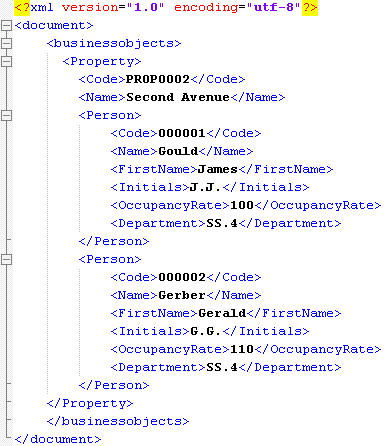Importing into multiple business objects – Field as super
To provide an example of importing nested data from an XML file into a multiple business objects
This example assumes an import definition is available and configured correctly. |
Enterprise Talk > Definitions > select the definition and, on the action menu, click Run.
Let’s assume you want to import a list of staff members and their related properties from an XML file into Planon ProCenter . On the Definition details level, your import definition must list the fields whose data you want to import.
The XML file contains data fields from two business objects:
• Personnel
• Properties
Therefore, on Business object definitions selection level, both business objects must be defined. |
You want to import the following fields:
Node name in XML | Field name in Planon ProCenter |
|---|---|
Person | |
Code | Code |
Name | Surname |
OccupancyRate | Occupancy rate |
Department | Department |
FirstName | First name |
Initials | Initials |
Property | |
Code | Code |
Name | Name |
Import file

Since your main business object is Property, in the XML, the Property data is included at a higher level to the Person data. Consequently, on the Definition details level, the Property reference must be added as super to the Person business object. |
As visible in above import file reference fields, in this case the Department field, can also be populated directly by using the lookup value. In general the code of a referenced BO can be used. For department the lookup value is the codegroup field since the business object is hierarchical and the code not unique.
Result
Before import, Gerald G.G. Gerber and James J.J. Gould were not in the list of personnel. After import, both persons are added to the list of personnel and the count is updated.
In addition, in Personnel TSI > Properties, the property Second Avenue is now added to the list.